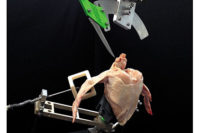In order to reduce core temperatures and control microbial activity on processed poultry, carcasses are currently immersed in specialized chillers. These large tanks are typically filled with chilled water that cools the carcasses to temperatures needed to inhibit pathogen growth, which historically have been near 4°C. The process, however, uses a considerable amount of water and energy along with the additional cost of chemical disinfectants. Researchers at the Georgia Tech Research Institute (GTRI) are exploring the use of ice slurry as an alternative chilling medium.
Ice slurry contains tiny ice crystals that are formed by mixing water with a freezing point depressant, such as salt. The slurry is produced by a specialized mechanical process of forming or cutting/scraping. The result is a two-phase mixture of micro-sized ice and water with excellent chilling ability. The GTRI team, having learned of the fishing industry’s use of ice slurry as a coolant preservative, thought the same could hold true for poultry-processing operations.
“Ice slurry will give you more cooling capacity per unit mass of water, so the assumption is that if you use ice slurry you can reduce the amount of water needed and/or provide a quicker chill,” explains Dr. Comas Haynes, GTRI principal research engineer and project director.
Initial scaled experiments were performed to benchmark the ice slurry’s cooling capacity. One group of test runs used the ice slurry, while another group used conventional chilled water. The team found carcass core temperatures decreased on average nearly 25 percent more in 45 minutes within the slurry at an initial temperature of minus 1°C compared with 45 minutes within the chilled water at an initial temperature of 4°C.
The ability to pump slurry throughout a facility makes it much more manageable when compared with conventional ice, which can form relatively large blocks, and as a result, does not convey by pumping very well.
“Some people even call it liquid ice,” says Haynes, referring to the consistency of the ice slurry. “Even though technically it is ice, it is such a tiny, fine grain in the midst of liquid water that it can literally be pumped like water.”
This would be a benefit over the current process in terms of ice handling and transportation. With an ice slurry machine and holding tank, the slurry can be made on-site and then easily pumped to the existing chiller. In addition, the ice slurry can be made during off-peak hours (when lower-cost electricity rates are available) and stored for later in-plant use, helping to drive energy effectiveness and reduce average electricity cost per kilowatt-hour.
In addition to the thermal capacity benefits, the team is currently investigating the slurry’s potential as an antimicrobial aid. It was initially hypothesized that the ice slurry’s grain may act as a “scrubber” along the carcasses’ skin, helping to mechanically address potential microbes on the carcasses’ exterior, hastening disinfection and possibly improving the effectiveness of the chemical disinfectant. Experiments are underway using whole-bird carcasses inoculated with an antibiotic-resistant strain of Salmonella and chilled by either water or slurry that contains various levels of the antimicrobial agent peracetic acid (PAA). These carcasses are then compared with a control set of carcasses that are not chilled or treated.
Using a 50 ppm PAA concentration and 20 minutes of immersion, the initial results showed an average of 0.6-log reduction in pathogen presence versus the control set when using water chilling, while the slurry chilling showed an average 1.2-log reduction versus the control set.
The final pathogen count was four times less when using the slurry compared with the water chilling. Haynes says the team anticipates that further pathogen reduction may be possible through a more thorough investigation of processing conditions.
“Our ultimate goal is to develop a system-of-systems approach to poultry chilling,” says Haynes. This includes establishing an ice slurry system as a thermomechanical innovation for food safety — thermal in its capacity for rapid and colder chilling and mechanical for its presumed “scrubber” antimicrobial effect.
Haynes believes that considering a supplemental ice slurry system for existing or future plant operations that is optimized for specific poultry-processing applications like chilling and sanitation could be a winning proposition.
This research is conducted under GTRI’s Agricultural Technology Research Program with support from several industrial and government partners: IceSynergy and Highland Refrigeration have loaned ice slurry machines; whole-bird carcasses have been donated by a local poultry company; the USDA’s Russell Research Center has provided a laboratory-scale auger chiller; Enviro Tech Chemical Services has provided the peracetic acid (PAA) for antimicrobial tests; and representatives from Southern Company Services are providing sponsorship and technical advice in regard to electricity/energy savings. NP




Report Abusive Comment